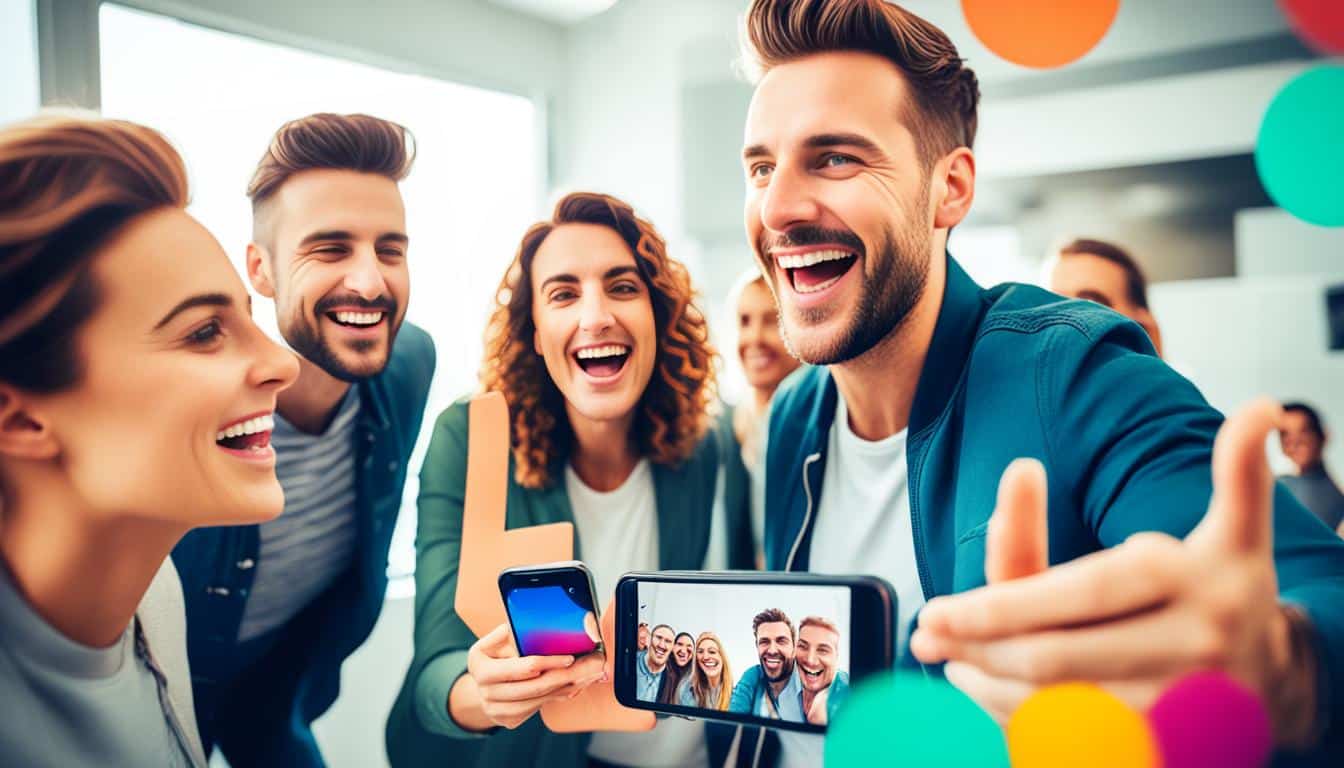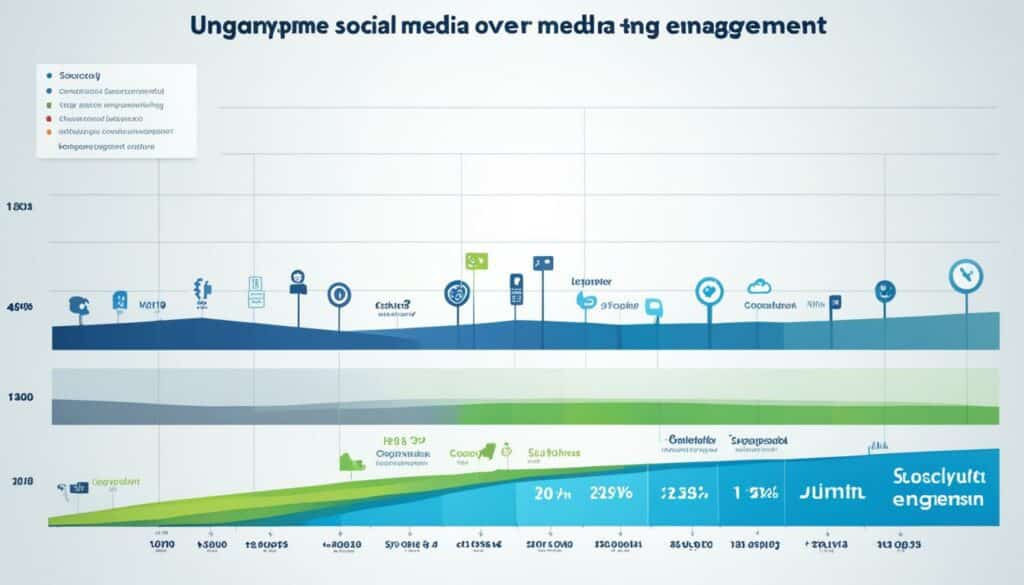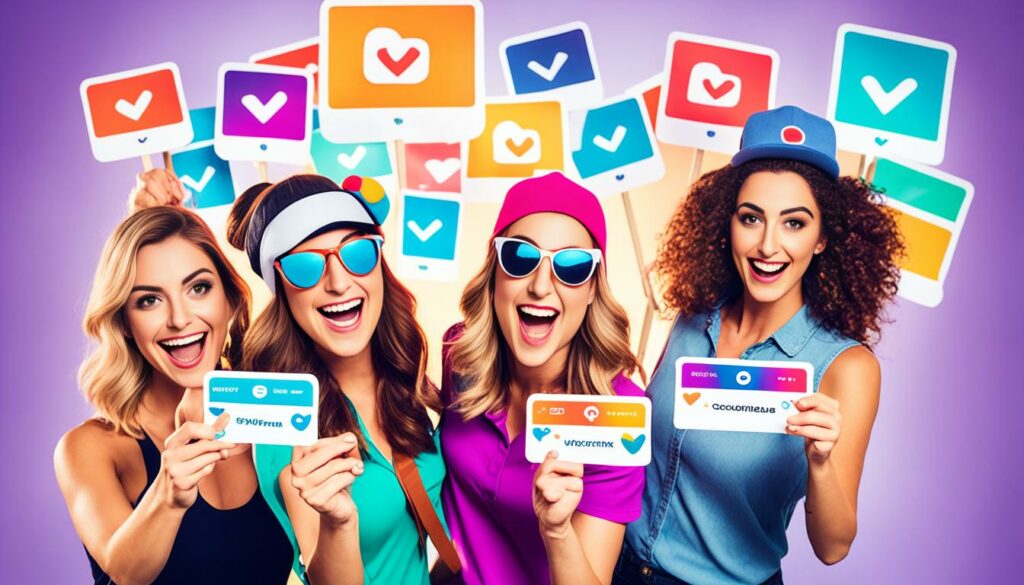Menu

Over 200 comments on a single social media post means a lot of people are interested. It’s the key to keep your audience engaged. When speaking with your followers, remember it’s not about the number of talks but the depth.
Anyone can create strong bonds with followers on social media. Focus on sharing real, helpful, and fresh ideas. Quick replies and reposting aid in getting more visibility, showing you’re committed to genuine engagement.
Being true and offering appealing content helps build real relationships with your audience. Aim to make followers feel they belong and matter. This will grow trust in your brand and expand your online influence.
Understanding social media engagement is key for brands to succeed online. We’ll look at what it is and why it’s so important to measure.
Social media engagement means the actions people take on social media. It can be likes, comments, shares, follows, or mentions. Different platforms have their own set of engagement actions. For example, Facebook includes clicks on call-to-action buttons and messaging a Page as engagement. Yet, Twitter, Instagram, and TikTok focus on likes, comments, and shares.
Measuring engagement is very important. It tells us how well our content is doing and what people like. For example, services like Buffer help us see how our audience interacts with our content. This can help a brand reach more people and become more influential. The Sprout Social Index™ shows videos, images, and live posts get a lot of engagement.
It’s also important to know how often and when to post. Posting 1-2 times a day is a good rule of thumb. This helps to improve how our content is seen and interacted with. Learning what kinds of interactions are valued by platforms like Facebook is crucial. It helps us spot trends and do better on social media.
Social media engagement is crucial for a brand’s success online. It’s important for businesses to grasp how engaging their content affects their image. Good engagement reveals what people like, giving your brand a good image.

To get people interacting, you should post things they find interesting. This builds brand loyalty and makes people recommend you more. Making meaningful posts helps your content reach more people, especially on platforms like Facebook.
How brands interact on social media really shapes what people think of them. Favourites and comments build a personal link, enhancing trust. Plus, social media algorithms promote posts that get a lot of interaction, spreading the brand’s message more.
Studies show over half of 18-54-year-olds like brands more when they receive good customer service online. So, talking to your community regularly helps your image a lot. It makes you more visible and can make customers more loyal.
Being active online helps your brand be seen more. Keeping an interaction rate of 1-3% is suggested. This way, you can see how well your content is doing. More interaction means more people see your posts.
Also, watching how many followers you get and seeing how often you’re talked about helps. This shows that by talking to people and showing real interest, your online presence will grow. It can even turn into more sales.
A clear strategy is vital for social media success. We will look at key ways to boost your campaigns.
Targeting the right audience is crucial. You must look at different groups like their age, interests, and online habits. This helps to make sure your message hits home.
Studies show making connections with customers gets you more followers. Team up with similar brands to draw in more people and increase engagement.
Planning posts and choosing the right time to share them keeps your message clear. A content calendar ensures your posts interest your audience and stay relevant. This strategy means post with purpose.
Knowing when your audience is most active helps. Analytics pinpoint the best times for your posts. This boosts the chance of your content being seen and interacting with users.
Instagram has over 2 billion users worldwide as of 2023. Its insights can help you make your posts more effective.
Engagement isn’t just about what you post. Responding quickly is key to growing a loyal community. Techniques include using Facebook groups or running interactive contests. These can all help you reach more people.
“68% of consumers follow a brand on social media to stay informed about new products or services.”
Understanding your social media engagement is key to seeing how well your posts perform. It means looking at things like how many people like, share, and comment on your posts. This kind of analysis helps you spot what’s doing well and what needs work.

It’s crucial to check if our posts match what our followers like. With tools such as Brand24, we can track what people say online about us. Checking the volume of these conversations helps to see how well people know and interact with our brand.
Knowing how followers feel about us is important. By looking at sentiment data, we can make our content better and our strategies more fitting. The data on trends we get from this informs smart changes in our strategies.
The share of voice metric informs how much we contribute to online talks. Advanced tech gives us clearer views on our influence online. It’s vital to grasp these numbers to ensure our efforts in marketing hit the mark.
| Platform | Engagement Indicator | Analysis Tool |
|---|---|---|
| TikTok | Views, Likes, Shares | Brand24 |
| Twitch | Comments, Mentions, Follows | Brand24 |
Social media is growing, and it’s key to connect with people through real, relatable content. This helps build strong relationships and trust with your followers. By sharing true stories and talking about your brand, you can make a personal link with your audience.
Each brand has its own story. By telling these stories, brands become more human, making them seem trustworthy and easy to relate to. In the latest social media trends, being true stands out. It helps build trust with people, who then become loyal customers. This way, brands don’t just talk about themselves; they share meaningful and real stories.
Real experiences make your brand more real and relatable. Stories from real life can make your brand story stronger and connect with people emotionally. This boosts interaction and shares. It can even lead to fans who support your brand, come back for more, and bring others with them.
Being real and creating relatable content is more than just a fad; it’s how brands build long-lasting connections. By being authentic and sharing real stories, you can gain a loyal community. This not only boosts your online presence but also grows your brand naturally.
| Element | Intersection with Social Media Objectives |
|---|---|
| Authenticity | Builds trust, fosters customer loyalty |
| Relatability | Encourages interactions and shares |
| Brand Storytelling | Humanises the brand, driving emotional connections |
| Real-life Experiences | Enhances emotional impact and brand narratives |
Using emotional triggers well on social media is key to getting people interested. The trick is to find emotions that your audience feels and use those to make your posts more interesting.
Feelings are very important for why we do things and how we choose. Happy adverts, for example, make life look better, pulling people towards cheerful posts. Fear, used in a good way, makes people act fast. Cybersecurity ads use this to point out online dangers and offer help. Understanding these emotions helps us make content that keeps people looking.
Making posts that touch people emotionally can really boost social media success. Mixing in surprises makes stories stick in people’s minds, sparking their interest. Showing you understand and care about their problems builds a strong connection. This makes people trust you more. It’s important to be honest and kind when using these emotional ideas. This builds even more trust.

Here is how different emotional posts can affect your social media success:
| Emotion | Impact | Example Usage |
|---|---|---|
| Happiness | Enhances quality of life, making users gravitate towards content | Brands sharing feel-good stories or positive news |
| Fear | Grabs attention and prompts action when used ethically | Cybersecurity warnings to offer solutions |
| Surprise | Captivates and engages users through unique storytelling | Unexpected twists in product launches |
| Empathy | Builds trust and rapport by showcasing understanding | Social media campaigns addressing common challenges |
Strategically using these emotional hooks can help us make posts that really connect with people. This can lead to more interaction and a stronger relationship with the audience.
Finding the best moments to post on social media is key. It boosts how many people see your posts and interact with them. Knowing when your fans are most online lets you plan your posts well. This way, more people get to see them.
Each social media site has a different time when posts work best. Knowing these can make a big difference in how many people like, share, or comment on your posts:
Using analytics is key to making your social media strategy work better. These tools give you a deep look at what your audience does. Then, you can adjust when you post to fit their schedule. For example, Instagram Business accounts find success posting 1.55 times daily, especially with carousel posts for better likes and comments.
On Facebook, putting up photos gets more love than just sharing links. And, over 80% of people use Facebook on their phones. LinkedIn is very trusted, with 82% of B2B marketers giving it a thumbs up. Plus, 40% of page visitors are interested in the posts they see on business pages.
All this information is gold for figuring out the best times to post. It can really take your post success and viewer numbers up a notch.
Using images and videos is key to doing well on social media. They boost how much people interact with your posts a lot. For example, carousel posts on Instagram businesses see a 3.15% jump in engagement. Marketers consider videos the most useful type of content for social media.
In a 2021 Statista survey, around 47% of adults liked brand content in images best, with 35% preferring videos. On LinkedIn, posts with images get almost double the comments than those without. This shows that using lots of visuals in your content plan is a smart move.

Using pictures and videos is vital to get your audience talking more. People are much more likely to read something if it’s colourful. Also, social media posts with images can get way more interaction than posts without. For example, Facebook posts with images do 2.3 times better.
It’s really important to share high-quality videos and pictures of your brand. When you do it right, visual content is 40 times more likely to be shared. Also, always make sure you’re allowed to use the images and videos. This way, you won’t run into any legal problems while trying to catch your audience’s eye.
| Platform | Preferred Visual Content | Engagement Increase |
|---|---|---|
| Carousel Posts | 3.15% | |
| Image Posts | 98% Higher Comments | |
| Posts with Images | 2.3X More Engagement | |
| Posts with Videos | 10X More Engagement |
Start your videos with something that grabs people’s attention. Research shows they’ll remember 80% of what they saw. And, a whopping 84% feel like buying something after watching a product video. So, clearly, video and other visuals are a must in any good content plan.
To truly connect with your audience on social media, you need two key things. First, make content that people find interesting. Second, know when to share it for impact. This shows that the type of content you choose affects how visible you are online.
All content isn’t the same, and some things work better for engagement. Take user content, educational posts, and fun stuff; they each grab attention in their way. For example, Southern Elegance Candle Co. boosted their sales a lot. They did this by sharing a mix of short videos, images, and live content. On Instagram, video posts get way more likes and comments than only text.
When you post is as important as what you post. The Sprout Social Index™ says sharing 1 to 2 posts daily is best. Also, target times when your followers are most likely online. This ensures more people see and engage with your content. Also, reply quickly on Twitter; most users expect a response in an hour. This means using analytics to decide when to post can really boost your content’s success.
Here’s a detailed comparison based on the type of content and its engagement potential:
| Type of Content | Engagement Potential |
|---|---|
| User-Generated Content | High, increases authenticity and trust |
| Educational Posts | Moderate, builds authority and provides value |
| Entertaining Material | High, drives likes, shares, and comments |
| Short-Form Videos | Very High, highly shareable |
| Live Videos | Very High, real-time engagement |
Today, it’s key to offer value to get engagement and loyalty on social media. By solving people’s problems and teaching them, we connect better. This builds trust with our audience.
Helping people with their issues is a top way to add value. It boosts engagement and trust in your brand. Giving them solutions makes people more likely to interact and trust you later. Studies show that businesses who focus on solving problems see more loyalty.

Teaching the audience is essential. By sharing expert insights or tutorials, your brand looks knowledgeable. It also builds a good info source people want to share. Mix of formats like articles and videos can boost engagement and marketing results.
Combining problem-solving with educating strengthens your brand. It also grows trust and engagement on social media. By focusing on making followers’ experience better, you pave the way for long-term success for your brand.
Engagement through contests and giveaways to boost interaction on social media works really well. They engage people and offer great prizes, making them social media incentives. For example, contests on Instagram, Facebook, and Twitter can attract more followers and make people notice your brand. A giveaway run by The Messi Store on Instagram got over 10,000 people to join, tagging their friends. This shows how powerful these strategies can be.
Contests and giveaways on social media can spread your brand’s name widely. By asking people to share or tag their friends, brands gain new followers. Making people engage through contests is also key. It can drive more website visits and leads. Asking for contact details turns into future sales chances. Or, by selling entries, you can boost immediate sales and make your promotions urgent.
Almost three billion people all over the world are on social media. This means there’s a huge group to engage with. Seasonal contests can focus people’s interest and highlight specific items or services. Plus, contests like writing ones can find skilled writers. They can tell your brand’s story in a captivating way, building a strong customer connection.
By using giveaways to boost interaction online, brands get many benefits. They increase how people engage and help grow a loyal, active audience. This all leads to a stronger online presence for the brand in the end.
Encouraging user-generated content (UGC) boosts the creation of content by users. This improves the brand’s authenticity. In the online world, 90% of people trust content created by other users more than ads. This high trust level leads to more people adding their own content. So, UGC becomes a key part of any brand’s marketing.

User-generated content brings many benefits. It offers real, honest content that speaks to people. 74% of buyers check social media before making purchases, showing the impact of recommendations. Brands sharing UGC build stronger bonds with their audience. This makes 53% of consumers more loyal to these brands on social media. Also, 86% trust UGC, while only 12% trust paid influencers.
There are a few ways to get more content from your users. Contests and giveaways work really well. For example, a hashtag contest got over 1,844 emails in under 3 days. Using hashtags, as Lululemon does with #thesweatlife, and LaCroix with #LiveLaCroix, boosts the visibility of UGC. This not only brings in more content but also builds a strong community. Asking followers to share their stories or reviews keeps the content fresh and real.
Using analytics for social media is key to improving strategies. These tools show how well your content is doing and where to make it better. This helps brands create campaigns that really connect with people.
To understand your audience, you must track things like how often they engage, click, and buy. The engagement rate shows how much people interact with your posts. Click-through rate shows what percentage of people click on your links or CTAs.
This lets brands see how effective their content is, helping them make it better.
There are many tools to help you keep an eye on how people interact with your posts. Platforms like Facebook, Twitter, and Instagram have their own tools. They give you real-time updates. But, tools like Hootsuite and Buffer offer even more detailed info.
A/B testing lets brands see which campaign version works best. This is useful for planning future strategies.
Table illustrating comparisons:
| Tool | Feature | Benefit |
|---|---|---|
| Hootsuite | Comprehensive Analytics | Detailed engagement metrics tracking and reporting |
| Buffer | Post Scheduling | Optimised posting times for increased engagement |
| Sprout Social | Advanced Listening | Enhanced understanding of audience sentiments and trends |
These analytics tools help brands keep their content interesting and engaging. They make sure brands are making decisions based on data, leading to better connections and a stronger social media presence.
Creating a strong social media community means making spaces where people can talk together. In 2023, there will be an amazing 4.89 billion people on social media. Brands need to talk back when people leave comments or ask questions. About 35% of people hope for a response within two hours. Quick and personal chats are key.
Talking both ways is super important. Brands become more friendly and close with their audience this way. Sprout helps by making chatting online easier. Look at Candy Funhouse – it grew big online with its 3.3 million TikTok fans. This shows the powerful effect of social media done right.
Feeling like you belong matters a lot. People like brands that share values and fun content. A quarter of shoppers choose brands that they feel align with them. During lockdown, ASOS sold more by being caring online. They used pictures, videos, and info images well. These types of content really capture people’s attention.
Keeping your content new and relevant is key. This makes your audience feel they are a part of something. It also makes them loyal to the brand. For more advice, check out this social media guide.
To get followers involved on social media, try chatting with them and answering quickly. Also, share real and eye-catching content. By talking often and truthfully, you really connect with them. This boosts how lively your social media is.
It’s about how much your followers interact with what you post. This includes likes, comments, and sharing your posts. It shows if your posts strike a chord with your group.
Knowing how much people interact with your posts is key. It helps improve your ad strategies. This way, you can keep your posts fresh and interesting for your fans.
More interaction on social media shows your brand’s content fits well and builds a positive image. Followers that get involved tend to stick around and promote your brand.
The more your posts are liked or shared, the more people see your content. This grows how many see you online and brings in new followers.
Identifying your crowd starts by looking at who follows you and how they act. Knowing them well helps create posts that catch their eye and match their interests.
It means planning and posting your content when your audience is most active. This keeps you posting regularly and boosts interaction by targeting the best times.
Studying the interaction with your posts shows what works and what doesn’t. Using tools to watch how your posts are doing helps improve your strategy.
Sharing your brand’s journey and its goal in a way people can relate to is powerful. Adding personal stories makes your content more interesting and builds a strong link with your fans.
Real stories make your brand seem more honest and engaging, making followers trust you more. They’re more likely to engage with such stories.
Emotional posts help followers feel connected, encouraging them to interact more. They build deeper relationships with your brand.
To ‘hook’ emotions, you need to know what moves your audience and use such themes in your posts. This includes sharing heartfelt stories or experiences your audience can relate to.
The best time to post varies, based on when your followers are most active on each platform. Check analytics to find these peak times.
Analytics show when your followers are online the most. Using this data to post at active times can improve how many see and interact with your posts.
People like and share images and videos more than text. Using eye-catching visuals can draw more people to your content, upping interaction.
Posts that people make themselves, educating posts, and fun posts are all great. Find out what your followers love to keep them engaged.
Posting at the right time ensures more of your followers see your content when they’re most likely online. This increases chances for engagement.
Solving your followers’ issues through your posts makes you a helpful choice. It makes them interact with and stay loyal to your brand.
Teaching your followers something new and useful is essential. It keeps them coming back for more, as they value your insights and share your content.
By offering prizes, you get more likes, comments, and shares. This boosts your content’s reach and visibility.
People trust what other users say more than a brand’s own message. Using content your users create builds trust and community.
Invite your followers to share their stories with a unique hashtag or by writing reviews. It makes them feel part of something and keeps them engaged.
Use tools that watch how your posts are liked, shared, and commented on. They help you see what works and how to improve.
You can use Google Analytics, Hootsuite, or Sprout Social for detailed insights. They show how your audience interacts with your content, helping you tailor your strategy.
Talk with your followers, encourage them to comment, and post things they can interact with. This makes your community feel more real and connected.
It makes followers feel they’re part of something, which boosts loyalty. A strong community is more likely to support and spread the word about your brand.